Written by Nash Sivaganesh, AVP - Verizon
1 The Opportunity
Advancements in 5G, cloud offerings, Autonomous networks and partnerships with satellite provides have provided CSPs numerous opportunities to accelerate monetization of their network by creating strategic opportunities and commercializing network assets. Current legacy OSS platforms are not equipped to deliver these opportunities fast enough. Network Monetization requires CSPs to transform to a flexible Order Management platform that allows multiple operators to utilize cross telco network assets. CSPs and Device vendors are transforming to a multi domain supporting platform that is cloud native, software driven and vendor agnostic ecosystem. Such a platform is enabled with a set of customizable services, configurable workflows. Telecom operators are modernizing the ecosystem to eliminate the challenges in the legacy network domain platform
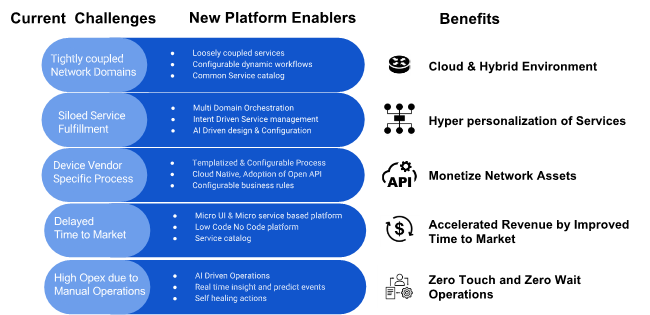
1.1 Current Challenges in Legacy Order Management Platforms
- Highly customized and tightly coupled with network elements: Extensive customization and tight coupling with network hardware and software are hallmarks of legacy OSS environments. This approach, while specific to initial deployments, results in significant vendor lock-in, hinders flexibility, and makes integrating new technologies or services a complex and lengthy process. Consequently, traditional OSS platforms, designed for older; static networks, are ill equipped for the demands of modern, dynamic, software-defined, and cloud-native telecom infrastructure.
- Fragmented & Siloed Systems: Key challenge of legacy OSS is its fragmented and siloed nature, where critical operational functions are handled by separate, often non-interoperable, systems. This systemic fragmentation causes significant operational inefficiencies and obstructs end-to-end service visibility, making it difficult to manage converged services effectively. By preventing seamless data flow and process integration, these siloed systems act as major barriers to innovation. This internal disarray directly translated to a poor customer experience, as CSPs cannot deliver the unified, real-time, and personalized service interactions customers now demand, impacting satisfaction and retention.
- Complex, Costly & Time-Consuming Development Integration: Integration of new services or network technologies into legacy OSS is notoriously complex, expensive, and slow. The bespoke nature of these systems, outdated architectures, and accumulated technical and process debt demand extensive development, and testing even for minor changes. This severely limits services agility and drastically lengthens TTM for new offerings, creating a competitive disadvantage for CSPs.
- High Capital and Operational Expenditure:Legacy OSS platforms are associated with substantial capital expenditure for initial deployment and ongoing hardware and software licenses, as well as high operational expenditure for maintenance, support, and the skilled personnel required to manage the complexity.
- Limitations to cross-selling Wireline /Wireless bundled products: The rigid and siloed nature of legacy OSS often restricts a CSP’s ability to easily create, provision, and manage bundled products, particularly those that combine wireline and wireless services or integrate offerings from multiple partners. This ability to effectively cross-sell limits revenue growth opportunities and fails to meet evolving customer demands for converged, all-in-one solutions.
- Customized Workflows for Network Vendors: Many legacy OSS environments feature workflows tailored to network equipment vendors. This customization, while perhaps beneficial with a primary supplier, impedes multi-vendor strategies and interoperability, leading to technical debt and vendor lock-in. This directly opposes the agility and flexibility essential for NextGen services and the adoption of diverse solutions.
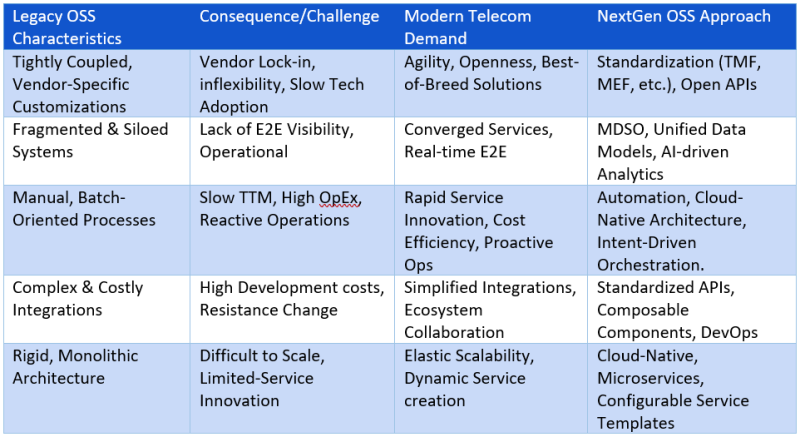
1.2 Enablers of NextGen Order Management
Intent Driven orchestration (IDO): From business intent to Network Action
IDO is a key enabler for Netgen OSS, combining AI and automation with service orchestration and assurance. Instead of manual, low-level configurations, IDO allows network resources to dynamically adjust based on predefined business intents. This is crucial for managing the complexity of modern cloud-native networks and 5G deployments.
IDO systems interpret high-level business objectives, even those expressed in natural language, and automatically translate them into specific technical requirements to instantiate network slices or services in real-time. This abstraction offers business-level control over the network.
The main benefits of IDO include faster service deployment, reduced operational costs through minimized manual intervention, and improved network performance and service quality. It empowers CSPs to innovate by focusing on service creation rather than complex configurations. Technically, IDO relies on sophisticated planning, scheduling, and AI Agents for intent translation and continuous assurance.
The power of Standardization: GSMA, MEF, TMF, IETF, 3GPP & Aduna Alignment
Alignment with industry standards is a cornerstone of NextGen OSS, ensuring interoperability, reducing complexity, and fostering a vibrant multi-vendor ecosystem. Several Key organizations and initiatives drive this standardization:
TM Form (TMF): Provides the ODA and Open APIs for modular, interoperable OSS/BSS, guiding practical implementation.
GSMA: Focuses on mobile, defining network slicing templates and driving the Open Gateway initiative (with CAMARA) for standardized network API access.
MEF: Standardizes Lifecycle Service Orchestration (LSO) APIs for automating inter-provider and intra-provider service operations aligning with TM Forum.
IETF: Contributes crucial standards for underlying network technologies and transport layer protocols essential for network slicing.
3GPP: is key for 5H network standardization, including the technical specifications for network slicing.
Aduna: A commercial venture built on CAMARA, aims to provide a unified platform for globally standardized network APIs, fostering the API economy.
Collectively, these efforts ensure interoperability, reduce complexity, and support a multi-vendor ecosystem, which is critical for NetGen OSS and advanced service delivery like NaaS.
Cloud based environment & AI driven Operations
NextGen OSS architecture is increasingly cloud-native and deeply integrates Artificial Intelligence for operational intelligence and automation.
Cloud-native environments, utilizing microservices, containers and DevOps offer critical benefits such as scalability to handle fluctuating workloads (5G, IoT), flexibility for rapid service deployments (reducing time-to-market), and cost-efficiency through optimized CapEx and OpEx. Public clouds also provide global reach, reliability, security, and readily available AI/ML services.
AI-driven operations are moving towards intelligent, predictive, and even agentic capabilities. A crucial factor for successful AI, especially agentic AI, is a robust and unified data strategy. AI models need access to high-quality, comprehensive, and contextualized data, with platforms enabling unified data access being key.
Technical enabler for this paradigm includes AIOps frameworks, cloud-native architectural patters, and strategic use of open-source technologies, allowing CSPs to build efficient, intelligent, and adaptable OSS environments.
Automated Programmable Orchestration & Configurable components
Systems are designed with modular, configurable components and programmable interfaces, allowing for rapid service creation and modification.
2 NextGen Service Fulfilment Paradigm Shift

2.1 Network Foundations
Industry offers telco operators the AIOps solutions for combining big data and AI, Machine Learning, and Machine Reasoning capabilities. These solutions improve and automate event monitoring, event correlation, service management, and more. Improve the network efficiency by Integrating Network Management System NMS and IT Service Management and customizing the remediation workflows by AI models.

2.2 AI Foundations
Service providers offer AIOps solutions for combining big data and AI, Machine Learning, and Machine Reasoning capabilities. These solutions improve and automate event monitoring, event correlation, service management, and more. Integrating Network Management System NMS and IT Service Management and customizing the remediation workflows by AI models.
AI Foundation leverages the Knowledge graph to represent the related network entities in a structured data representation to improve the AI performance and perform advanced reasoning.
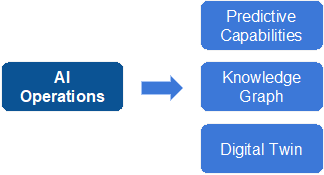
2.3 IT Foundations
Modernized IT ecosystem that accelerates the quicker & Effective development cycle, leveraging Low Code No Code (LCNC) platform, Cloud Native applications designed to scale dynamically and maintain resilience while failure. Telco are in demand to adapt the flexible & configurable platform that orchestrates to multiple network domains. Modernized ecosystem supported with the capabilities to be interoperable with other telcos through Industry standard Open API like TMFORUM, Metro Ethernet Forum (MEF), 3GPP and Aduna standard API. Orchestration platform that enables flexibility based on business requirements and loosely coupled configurable functions.
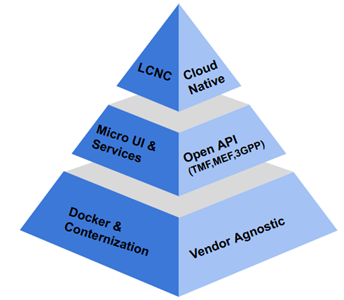
2.4 Operations Foundations
Telcos are fundamentally transforming the operations foundations that can support growing demands for services and capacity. Operations will need to ensure Network and IT applications infrastructure is protected against threats, ensuring data privacy by adhering to the industry and global data compliance. Transparency and unified visibility of QOS across the network management and the interdependency on the network domain operations will enable high quality service to customers. Reduce human intervention and enable the Zero-Touch operations by automating the routine tasks using AI and ML models.
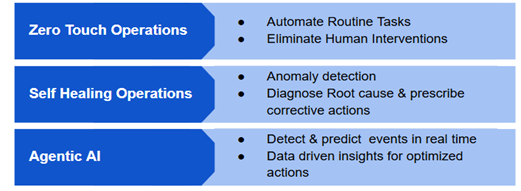
3 Multi Domain Service Availability and Orchestration
As network architectures grow increasingly complex, encompassing physical and virtualized resources across access, transport, core, 5G Wireless Access, Satellite access and cloud domains, often from multiple vendors, the need for sophisticated orchestration becomes paramount. Multi-Domain Service Orchestration emerges as a critical capability to manage complexity and enable agile, end-to-end service delivery. Multi service Visibility is an accelerating capability that enables unified visibility of all services available for a given location. This enables the customer’s choice available services and Sales to Cross/Up sell bundled solutions to customers.
Navigating Complexity is Modern Networks
Multi Domain Orchestration is a framework designed to automate, coordinate, and manage services across disparate network domains and diverse vendor environments. It acts as a higher-level control plane that enables CSPs to abstract the underlying network complexity and deliver seamless, end-to-end services. Key characteristics and functions include:
- Centralized Control and Visibility: Unified view and control point for services that span multiple technological and administrative domains, breaking down operational silos.
- Industry Standard Open API: Industry Standard API TMF 645 Service qualification API adoption leverage the Telco to use the common API to check service feasibility across wireline and Wireless broadband solutions
- Abstraction of Domain Complexity: Shielding the higher-level OSS/BSS and service catalogs from the intricacies of individual domain controllers and network technologies.
- Intent Based Service Availability check: Based on customer intent recommending the speed, Quality of Service and definition of the Latency for the services
- Hyper personalization of services: Recommending the services based on the customer profile
4 Key Success Factors
- New Product development cycle is faster with closely integrated process between Network, IT applications and Business
- Effective Life cycle management of service availability
- Single view of Location based available services to Sales, Marketing, IT & Network Engineering.
- Automate to facilitate the on-demand simulation for Broadband services at various speeds/QOS to B2C, B2B Customers
- Repository of common library, template, packages to offers network combo
- Automate to manage the data driven workflows and monitoring Service availability SLA. Integrated process to sync up service availability between the Service Assurance and Service availability system.
The contents of this whitepaper are solely based on experience of the author and is not to be considered as official Verizon-authored article.